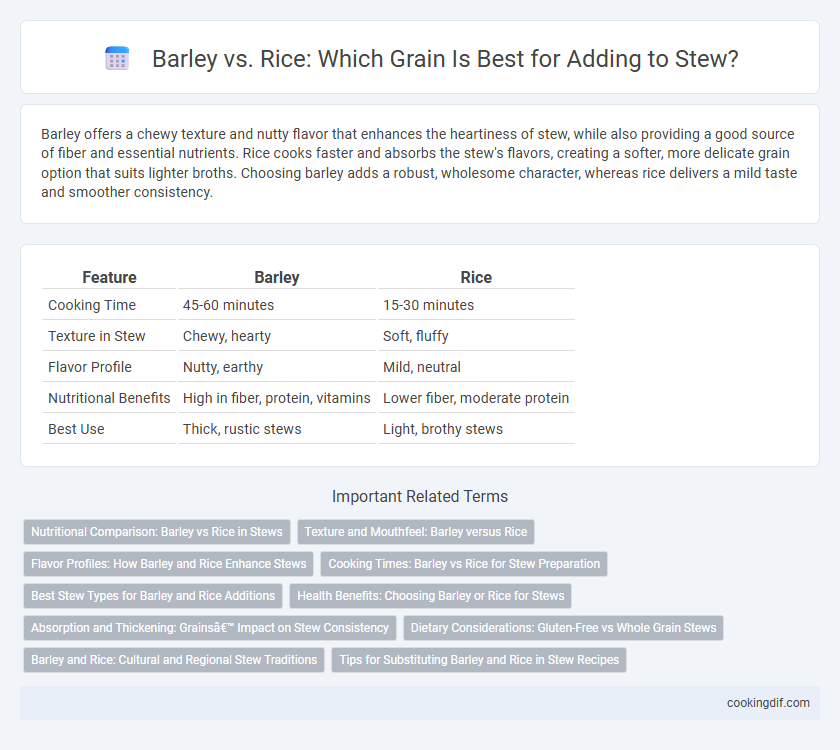Barley offers a chewy texture and nutty flavor that enhances the heartiness of stew, while also providing a good source of fiber and essential nutrients. Rice cooks faster and absorbs the stew's flavors, creating a softer, more delicate grain option that suits lighter broths. Choosing barley adds a robust, wholesome character, whereas rice delivers a mild taste and smoother consistency.
Table of Comparison
| Feature | Barley | Rice |
|---|---|---|
| Cooking Time | 45-60 minutes | 15-30 minutes |
| Texture in Stew | Chewy, hearty | Soft, fluffy |
| Flavor Profile | Nutty, earthy | Mild, neutral |
| Nutritional Benefits | High in fiber, protein, vitamins | Lower fiber, moderate protein |
| Best Use | Thick, rustic stews | Light, brothy stews |
Nutritional Comparison: Barley vs Rice in Stews
Barley contains higher fiber content and more protein compared to rice, enhancing the nutritional profile of stews with better digestion and sustained energy release. Rice offers a lighter texture and is lower in calories, making it suitable for lighter, easily absorbed meals. Both grains provide essential minerals, but barley is richer in manganese and selenium, which support metabolic health and antioxidant function in stew recipes.
Texture and Mouthfeel: Barley versus Rice
Barley offers a chewy and hearty texture that thickens stew, providing a satisfying mouthfeel with each bite, while rice delivers a softer, more tender grain that absorbs flavors but can become mushy if overcooked. The husky, slightly nutty character of barley adds complexity and a substantial body, contrasting with rice's mild taste and smoother consistency. Choosing barley enhances the stew's rustic robustness, whereas rice contributes a delicate, lighter texture suitable for brothy preparations.
Flavor Profiles: How Barley and Rice Enhance Stews
Barley lends a nutty, slightly chewy texture that enriches stew with its hearty, earthy flavor, creating a more robust and complex taste experience. Rice offers a mild, neutral backdrop that absorbs the stew's spices and broths, enhancing its overall warmth without competing with other ingredients. Choosing barley or rice affects the stew's mouthfeel and depth, where barley intensifies savoriness and rice provides a smoother, subtler grain complement.
Cooking Times: Barley vs Rice for Stew Preparation
Barley requires a longer cooking time than rice, typically around 45-60 minutes versus rice's 15-20 minutes, making it ideal for slow-simmered stews that benefit from extended cooking to fully develop flavors. Pearl barley softens and absorbs stew liquids while maintaining a chewy texture, whereas rice cooks faster but may become mushy if simmered too long. Choosing barley over rice enhances the stew's heartiness and thickens the broth naturally during the prolonged cooking process.
Best Stew Types for Barley and Rice Additions
Barley excels in hearty beef or vegetable stews, offering a chewy texture and nutty flavor that absorbs broth well, enhancing the rustic taste. Rice, particularly long-grain or jasmine varieties, is ideal for chicken or seafood stews where a tender, fluffy grain complements lighter, broth-based recipes. Combining barley with root vegetables creates a robust, filling stew, while rice pairs best with aromatic herbs and spices in Mediterranean or Asian-inspired dishes.
Health Benefits: Choosing Barley or Rice for Stews
Barley is rich in soluble fiber, which promotes heart health and regulates blood sugar levels, making it a nutritious grain option for stews. Rice, particularly brown rice, offers a good source of essential minerals and antioxidants while providing a gluten-free alternative suitable for sensitive diets. Both grains enhance stew's texture and nutritional value, but barley's higher fiber content delivers more substantial digestive and cardiovascular benefits.
Absorption and Thickening: Grains’ Impact on Stew Consistency
Barley absorbs more liquid than rice during cooking, resulting in a thicker, heartier stew consistency. Its soluble fiber releases starches that naturally thicken the broth, enhancing the stew's richness without additional thickeners. Rice absorbs less liquid, producing a lighter texture and less impact on viscosity, making barley the preferred grain for a robust, thickened stew.
Dietary Considerations: Gluten-Free vs Whole Grain Stews
Barley is a whole grain rich in fiber, vitamins, and minerals, but it contains gluten, making it unsuitable for gluten-free diets. Rice, particularly brown rice, offers a gluten-free option while also providing whole grain benefits like fiber and essential nutrients. Choosing between barley and rice depends on dietary needs, with rice preferred for gluten-sensitive individuals and barley favored for its robust nutritional profile in whole grain stews.
Barley and Rice: Cultural and Regional Stew Traditions
Barley is a staple grain in Northern and Eastern European stews, prized for its chewy texture and nutty flavor that complements hearty root vegetables and meats. Rice is predominantly used in Asian and Latin American stews, where its ability to absorb flavors creates a soft, comforting base. Regional stew traditions highlight barley's role in rustic, slow-cooked dishes from Scotland and Russia, while rice enhances the aromatic, spice-infused broths typical of Indian and Mexican cuisine.
Tips for Substituting Barley and Rice in Stew Recipes
Barley adds a chewy texture and nutty flavor to stew, absorbing liquid without becoming mushy, making it ideal for longer simmering times compared to rice. When substituting rice for barley, choose short-grain or medium-grain varieties and reduce cooking time to prevent overcooked, sticky results. Adjust liquid ratios accordingly: barley requires more water and longer cooking, while rice cooks faster and needs less broth to maintain stew consistency.
Barley vs rice for adding grains to stew Infographic

 cookingdif.com
cookingdif.com